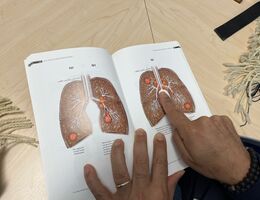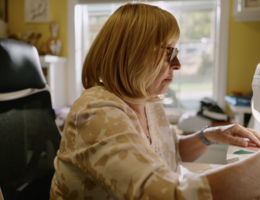

Don Staten (right) is grateful for his supportive husband, Michael, during his testing, diagnosis, surgery, and recovery from lung cancer.
Is secondhand smoke really an issue? Don D. Staten, OD, a retired optometrist, grew up with secondhand smoke exposure his entire childhood. When his mother battled lung cancer, he knew he needed to be vigilant about his lungs and took a proactive approach to his health. Decades after exposure, Staten underwent a single-anesthesia procedure that allowed him to be diagnosed and cancer-free in one event.
Staten practiced optometry in Reno, Nevada for decades. Upon retirement, he and his spouse moved to Southern California to enjoy the warmer climate. As a health-conscious individual, Staten regularly monitored his health, including periodic CT scans to check for any signs of lung issues. During one of these scans in July of 2022, his pulmonologist detected a concerning nodule.
The results from a PET scan and biomarker test came back inconclusive, with only a 4% chance of cancer. However, Staten trusted his instincts and sought out more options when he came across a patient success story, testifying about a procedure he was interested in.
Traditionally, the evaluation of lung nodules suspected of being cancerous required multiple steps: A biopsy to collect tissue samples, a separate biopsy to check for the spread of cancer to lymph nodes in the chest, then surgery to remove the nodule if found to be malignant. However, at Loma Linda University Health, medical teams have devised an innovative strategy that consolidates all these procedures into a single session, significantly simplifying the process and potentially speeding up treatment.
In September 2023, Staten saw Alexander Leung, MD, a thoracic surgeon at Loma Linda University Health, who deemed him an appropriate candidate for the single-anesthesia procedure.
Just one month later, Staten entered the hospital doors unsure and hoping the nodule in his chest was noncancerous.
"It’s not just about streamlining the process, it’s about providing compassionate care while offering the fastest, most effective treatment for lung cancer,” Leung said.
While under anesthesia, Staten underwent a robotic-assisted bronchoscopic biopsy by interventional pulmonologist, Elliot Ho, DO, to examine the lung nodule. With the aid of pathologists, the biopsy confirmed the presence of lung cancer. During the same procedure, his lymph nodes were examined and found to be free of cancer, indicating that the tumor was in an early stage. The surgical team, led by Leung, immediately proceeded to remove the cancer in the same anesthesia session.
"When I woke up after surgery, I was groggy, but my husband told me they had removed the suspect nodule and associated lobe," Staten said. "It was a relief to know it was gone and caught at stage one."
His recovery was swift. Despite the initial discomfort from having tubes and catheters, he was eager to get moving and was determined to be out of bed as soon as possible. His positive attitude and proactive approach to his health were significant to his recovery.
"Surgery ended at 5 p.m. and by the next morning I was already up and sitting in a recliner," Staten said. "Dr. Leung and his team came in and were surprised to see me out of bed. I told them, 'I'm not staying in that bed!'"
Staten is in good health and continues his follow-up appointments during a five-year surveillance period. Together Staten and his husband look forward to their retirement, traveling, gardening, and enjoying their community in Fallbrook.
Loma Linda University Health is nationally ranked in Pulmonology & Lung Surgery by U.S. News & World Report. If you have coughing, wheezing, shortness of breath, or a lung nodule found during a CT scan, visit your primary care doctor to determine if a referral to the Loma Linda University Health interventional pulmonology clinic is needed.



